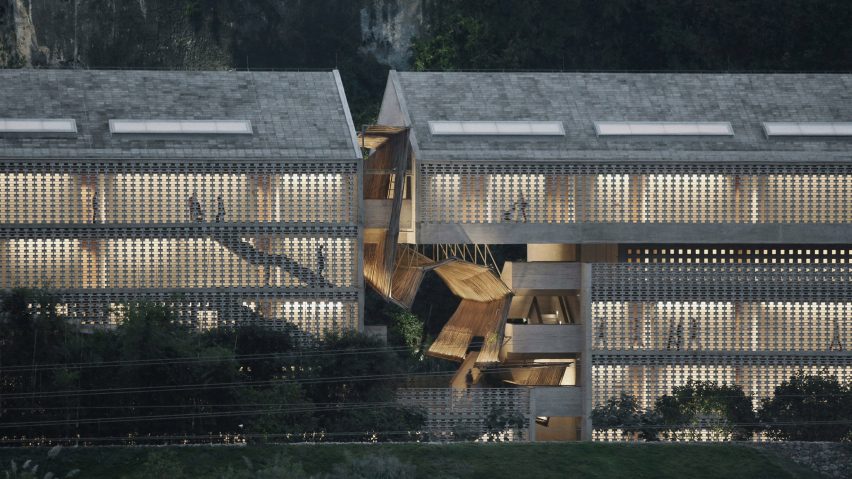Vector Architects has transformed a disused sugar mill in China's mountainous Yangshuo County into a resort hotel featuring a group of gabled masonry structures designed to complement the existing industrial architecture.
Alila Yangshuo hotel is situated in a col between two of the karst mountains that makes this area in the Guangxi region a popular destination for tourists looking to take in the picturesque scenery.
Beijing-based studio Vector Architects was tasked with creating a hotel on the site of the disused sugar mill, which was constructed in the 1960s and comprises a cluster of buildings alongside a truss used for loading sugar cane onto boats.
The project involved retaining and repurposing the existing structures and introducing new accommodation buildings that complement their industrial aesthetic. Interiors designed by Ju Bin of Horizontal Space Design aim to emphasise the connection between old and new.
The original buildings now contain amenities including the hotel's reception, a cafe, bar, multipurpose hall, gallery and library, which are all arranged around a reflecting pond and sunken plaza at the centre of the complex.
Flanking the old mill are a pair of new blocks housing a variety of rooms and guest suites. These additions feature gabled forms and a material palette that references the existing architecture.
"We kept the profile of the new buildings as simple as possible to avoid unnecessary distraction to the old sugar mill caused by overly expressive geometry," said the studio, which previously refurbished a house in a Chinese port by adding a vaulted concrete roof.
The cluster of shed-like structures are constructed using hollow concrete blocks and board-marked concrete with perforated surfaces that offer a lightweight and modern interpretation of the methods used to build the original mill.
"In order to create a sense of consistency, instead of simply copying the old materiality and texture, we try to seek this nuance where we use more contemporary materials and construction methods while retaining the tinge and masonry structure of the old," said the architects.
The new buildings are accommodated within landscaped grounds intended as a garden that guests can wander around to enjoy views of the landscape, ponds and planting.
Pathways connect the volumes with outdoor features including the sunken plaza and a swimming pool positioned within the former loading area that extends out towards the river.
The larger building called the Sugar House Retreat contains rooms with private balconies at the rear that look out across the mountain scenery.
The two-storey Garden Townhouse accommodates a series of suites facing the old buildings and ponds. At the rear, the upper suites open onto a private terrace, while the ground-floor suites look onto a bamboo garden.
Perforated screens created by combining solid and hollow concrete blocks help to provide natural light and ventilation throughout the buildings and circulation areas.
Along the front of the Sugar House Retreat, these surfaces screen the building from the nearby road. This side of the building is given over to corridors and staircases that connect the different levels.
The circulation areas are intended as an extension of the paths that extend throughout the complex. They are punctuated by full-height voids that function as open-air lobbies providing access to various staircases.
These openings are intended to evoke caves found in the surrounding mountains and offer views of the adjacent cliff face. The central void contains a sculptural bamboo canopy that meanders down through the floors.
Vector Architects has also previously transformed a former warehouse in Beijing into a museum with wire mesh draped over its entrance and designed a chapel that is raised above a beach so the tide can wash underneath it.

